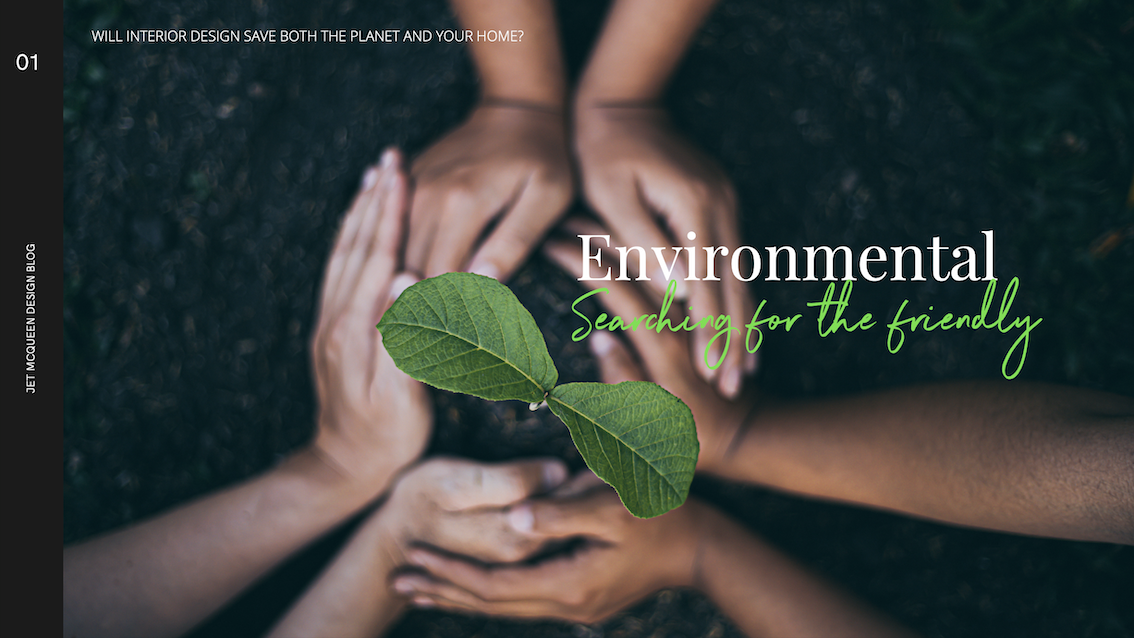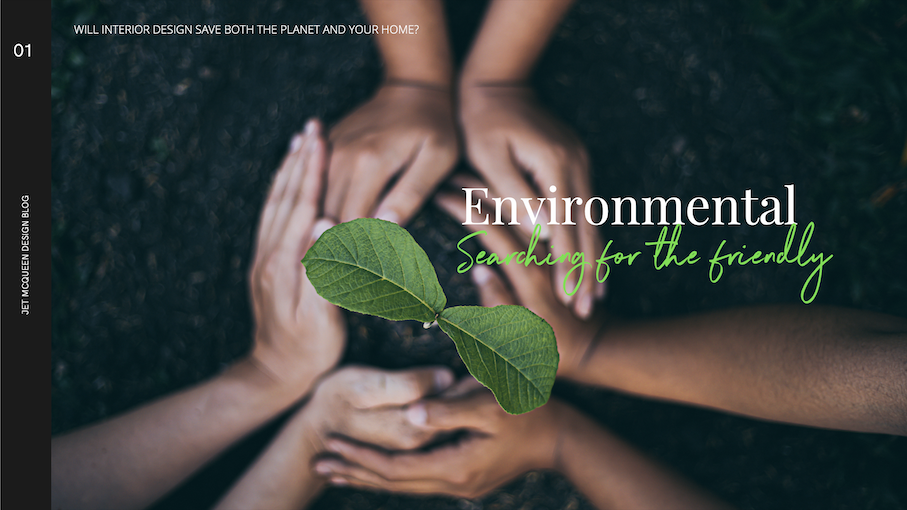Searching for the friendly
Can a monster industry pivot towards environmental friendliness?
In the last nine months I have visited many a design show. I have been hunting for a variety of reasons, but chief among them I’ve been looking for ways in which I can see the industry shift towards more eco-friendly alternative sources and materials. I am disappointed to report that we are not moving as fast as we need to on this. Yes, there are plenty of recycled or upcycled items. Plastics are being morphed into wall surfacing treatments, Old clothing is being recycled into carpets, Quarrying stones and marble is being replaced by Porcelain tiles and countertops, Natural fibres are beginning to be sourced in more local areas. This all sounds very good…except that when you investigate the products there are several drawbacks. Namely – Quality, Consistency, Selection, Cost, and Credentials.
Let’s start with the elephant in the room. The fact is none of the products I viewed would be considered “first choice” selections if I were working on a design. They just aren’t nice enough, good enough, eco-friendly enough….and that really does matter. These environmentally friendly materials might be selected if a client briefed that all contents in their design MUST be green. But in any other brief, they would never make it into the preferred source list. These substitutes just don’t feel, look, or perform well enough to hold their own next to the other non-GREEN options.
And that’s just not going to do it for the clients who care enough about aesthetics that they’ve hired an Interior Designer.
I have clients who are willing to spend more on an environmentally positive item that they love, but I am yet to meet a client who stands by their desire to be Green with such conviction that they are willing to select an inferior material for the protection of the environment. Recognizing this dilemma is important! Until the industry accepts that most people will not compromise their desires for a principle, it won’t recognize that it’s up to us to deliver an acceptable alternative.
As an industry we need to move as quickly as possible to a point where the Environmentally friendly products on the market are as good as, or better than the other options. It takes only one green vendor to reach a point of preference, for all other vendors to move to meet them. For every preferred green product (in cost, quality, and consistency) would eliminate the desire for any non- environmental product completely shifting the paradigm and the industry.
It was clear by walking through the Design & Surface show in February, that suppliers know that they need to be seen on an environmentally friendly platform, and that this is what clients (aka Designers) want to see. Stall after stall, each vendor promoted their Recycle, Reuse, Repurpose platform, and it was evident that we have reached the Marketing phase of “GREEN”. The front of each mat highlighted products presented as planet-happy revolutionising solutions.
This extended from carpets through to cleaning solutions, sustainable sourcing of organic materials like marble, through to organic paints and recycled and sorted demolition techniques and machinery which is changing the way old buildings are sorted between rubbish and recyclable items.
If you looked at the shell of this event, the result feels like a positive step-change towards a happy planet and responsible industry…. But below the surface the reality is a little murkier. If we magnify into the details, what we are really being confronted with is a front-facing promotion of a singular product “star” that has some redeeming level of GREEN credentials. This NEW star is being represented to increase the supplier’s credibility as a green source provider. Looking deeper at the supplier’s product line, 90% of the remaining products these vendors sell are not green, and their sales teams are quick to move you onto these products. This directly correlates with the volume of sales they generate when you ask about “best sellers”. And so,… we are back to the catch 22, where until the environmentally friendly, and carbon neutral products improve, clients won’t switch. When clients don’t buy, the suppliers invest less on the expansion of the range and the green offer remains underdeveloped and uncompetitive against the mainstream offer.
There are some innovative things coming forward to be excited about, and I was particularly encouraged by the number of vendors trying to work through solutions for recycled plastics. Although I am yet to be fully convinced by the look of recycled plastics for rugs, throws and blankets, I was impressed by the softness that can be achieved by processing these recyclable materials. We use fabrics in so many items in our homes and lives that this could be a real game changer for the planet. My hope is that technology and innovation will provide us with amazing alternatives for future products.
Before we get out our pompoms ready for a cheer, I think it’s important to get out our magnifying glass and look at the details in full. While we should celebrate the use of recycled plastics, we need to remember that just because a product employs a recycled element does not make it the Holy grail for the planet. Many of the toted “environmentally friendly” products still have a lot of unfriendly features that vendors are less keen to discuss.
A truly green item needs to consider a lot more than just its ability to recycle a waste item. Where many green products come unstuck is in the processing and logistics carbon footprint. For example, soft furnishing fabrics and recycled products fall below par on their green credentials because of their use of harmful dyes, alongside the deconstruction processing which uses harmful chemicals and excessive heat. To add to this processing generally utilises vast amounts of water which becomes waste. As if to add insult to injury, many have a terrible carbon footprint with recycled items being flown from one location, to be processed in another, and woven in yet another and then finally delivered to the locations around the world.
While finding solutions to one waste problem is commendable, it is harder to rubber stamp or justify these efforts when new problems in another area of environmental concern are caused. It is an end-to-end environmental solution that envelops a truly Green product, and companies who can comply with this comprehensive approach to friendly products need to be encouraged and potentially funded to fuel the development. Perhaps future Green products need to be government regulated and approved so that they may be coded to effectively communicate the level of environmental consideration they have in all aspects from design to consumer. Afterall, even the government inadvertently adds to some of the non-green features such as the coatings required on fabrics for fire guard.
There is hope!
I don’t want you to be too discouraged by my recent explorations. While there were fewer solutions and products than what I was hoping to find …, there were also some very positive signs. The fact is, ten years ago no one was taking the time to promote GREEN. Now having a Green platform is seen as an essential part of a company ethos. To me, this suggests that in future we will see more dedication towards the development of truly amazing environmentally positive products that are sustainable and responsible – beyond just the surface promotion of a singular product offer.
Awareness
The fact that most vendors are aware that GREEN is the demand the market is after means that they also know this is the way forward. It suggests that they are investing not just in marketing, but we should assume they are also investing in developing better green technologies, processes and ultimately products. Changing any industry (no less an aesthetic one) is often slow and it can be costly. Preferential products and demand for them are the key to making the fastest shifts.
Vendors will move their offer to where the money is being spent, and so the more clients with Green principles willing to put the money behind their planet friendly intent, the more products we will see come forward. In this, it is a combination of factors to consider, but as we see the climate change we are aware that Green products are a need and not a want.
What can you do?
To you, I say…”keep diving deeper and beyond the green product being promoted to you, look at its development and planet credentials (processing and the logistics journey). Want more than just a label, want to know what it has gone through to morph into its latest iteration. Keep looking and demanding “Green” and hopefully the next Design-led show I search through will yield some market leading results that I can share with you on the next design brief.



Comments are closed